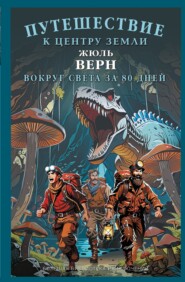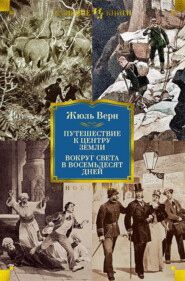По всем вопросам обращайтесь на: info@litportal.ru
(©) 2003-2025.
✖
From the Earth to the Moon, Direct in Ninety-Seven Hours and Twenty Minutes: and a Trip Round It
Настройки чтения
Размер шрифта
Высота строк
Поля
"My worthy friend, we cannot do better than sink our Columbiad in these high grounds."
"To get nearer to the moon, perhaps?" said the secretary of the Gun Club.
"Not exactly," replied Barbicane, smiling; "do you not see that amongst these elevated plateaus we shall have a much easier work of it? No struggles with the water-springs, which will save us long and expensive tubings; and we shall be working in daylight instead of down a deep and narrow well. Our business, then, is to open our trenches upon ground some hundreds of yards above the level of the sea."
"You are right, sir," struck in Murchison, the engineer; "and, if I mistake not, we shall ere long find a suitable spot for our purpose."
"I wish we were at the first stroke of the pickaxe," said the president.
"And I wish we were at the last," cried J. T. Maston.
About ten a.m. the little band had crossed a dozen miles. To fertile plains succeeded a region of forests. There perfumes of the most varied kinds mingled together in tropical profusion. These almost impenetrable forests were composed of pomegranates, orange-trees, citrons, figs, olives, apricots, bananas, huge vines, whose blossoms and fruits rivalled each other in colour and perfume. Beneath the odorous shade of these magnificent trees fluttered and warbled a little world of brilliantly plumaged birds.
J. T. Maston and the major could not repress their admiration on finding themselves in presence of the glorious beauties of this wealth of nature. President Barbicane, however, less sensitive to these wonders, was in haste to press forward; the very luxuriance of the country was displeasing to him. They hastened onwards, therefore, and were compelled to ford several rivers, not without danger, for they were infested with huge alligators from fifteen to eighteen feet long. Maston courageously menaced them with his steel hook, but he only succeeded in frightening some pelicans and teal, while tall flamingos stared stupidly at the party.
At length these denizens of the swamps disappeared in their turn; smaller trees became thinly scattered among less dense thickets – a few isolated groups detached in the midst of endless plains over which ranged herds of startled deer.
"At last," cried Barbicane, rising in his stirrups, "here we are at the region of pines!"
"Yes! and of savages too," replied the major.
In fact, some Seminoles had just come in sight upon the horizon; they rode violently backwards and forwards on their fleet horses, brandishing their spears or discharging their guns with a dull report. These hostile demonstrations, however, had no effect upon Barbicane and his companions.
They were then occupying the centre of a rocky plain, which the sun scorched with its parching rays. This was formed by a considerable elevation of the soil, which seemed to offer to the members of the Gun Club all the conditions requisite for the construction of their Columbiad.
"Halt!" said Barbicane, reining up. "Has this place any local appellation?"
"It is called Stones Hill," replied one of the Floridans.
Barbicane, without saying a word, dismounted, seized his instruments, and began to note his position with extreme exactness. The little band, drawn up in rear, watched his proceedings in profound silence.
At this moment the sun passed the meridian. Barbicane, after a few moments, rapidly wrote down the result of his observations, and said, —
"This spot is situated 1800 feet above the level of the sea, in 27° 7' N. lat. and 5° 7' W. long. of the meridian of Washington. It appears to me by its rocky and barren character to offer all the conditions requisite for our experiment. On that plain will be raised our magazines, workshops, furnaces, and workmen's huts; and here, from this very spot," said he, stamping his foot on the summit of Stones Hill, "hence shall our projectile take its flight into the regions of the Solar World."
CHAPTER XIV.
PICKAXE AND TROWEL
The same evening Barbicane and his companions returned to Tampa Town; and Murchison, the engineer, re-embarked on board the "Tampico" for New Orleans. His object was to enlist an army of workmen, and to collect together the greater part of the materials. The members of the Gun Club remained at Tampa Town, for the purpose of setting on foot the preliminary works by the aid of the people of the country.
Eight days after its departure, the "Tampico" returned into the bay of Espiritu Santo, with a whole flotilla of steamboats. Murchison had succeeded in assembling together fifteen hundred artisans. Attracted by the high pay and considerable bounties offered by the Gun Club, he had enlisted a choice legion of stokers, iron-founders, lime-burners, miners, brickmakers, and artisans of every trade, without distinction of colour. As many of these people brought their families with them, their departure resembled a perfect emigration.
On the 31st October, at ten o'clock in the morning, the troop disembarked on the quays of Tampa Town; and one may imagine the activity which pervaded that little town, whose population was thus doubled in a single day.
During the first few days they were busy discharging the cargo brought by the flotilla, the machines, and the rations, as well as a large number of huts constructed of iron plates, separately pieced and numbered. At the same period Barbicane laid the first sleepers of a railway fifteen miles in length intended to unite Stones Hill with Tampa Town. On the first of November Barbicane quitted Tampa Town with a detachment of workmen; and on the following day the whole town of huts was erected round Stones Hill. This they enclosed with palisades; and in respect of energy and activity, it might have shortly been mistaken for one of the great cities of the Union. Everything was placed under a complete system of dicipline, and the works were commenced in most perfect order.
The nature of the soil having been carefully examined, by means of repeated borings, the work of excavation was fixed for the 4th of November.
On that day Barbicane called together his foremen and addressed them as follows: – "You are well aware, my friends, of the object with which I have assembled you together in this wild part of Florida. Our business is to construct a cannon measuring nine feet in its interior diameter, six feet thick, and with a stone revetment of nineteen and a half feet in thickness. We have, therefore, a well of sixty feet in diameter to dig down to a depth of nine hundred feet. This great work must be completed within eight months, so that you have 2,543,400 cubic feet of earth to excavate in 255 days; that is to say, in round numbers, 2000 cubic feet per day. That which would present no difficulty to a thousand navvies working in open country will be of course more troublesome in a comparatively confined space. However, the thing must be done, and I reckon for its accomplishment upon your courage as much as upon your skill."
At eight o'clock in the morning the first stroke of the pickaxe was struck upon the soil of Florida; and from that moment that prince of tools was never inactive for one moment in the hands of the excavators. The gangs relieved each other every three hours.
On the 4th of November fifty workmen commenced digging, in the very centre of the enclosed space on the summit of Stones Hill, a circular hole sixty feet in diameter. The pickaxe first struck upon a kind of black earth, six inches in thickness, which was speedily disposed of. To this earth succeeded two feet of fine sand, which was carefully laid aside as being valuable for serving for the casting of the inner mould. After the sand appeared some compact white clay, resembling the chalk of Great Britain, which extended down to a depth of four feet. Then the iron of the picks struck upon the hard bed of the soil; a kind of rock formed of petrified shells, very dry, very solid, and which the picks could with difficulty penetrate. At this point the excavation exhibited a depth of six feet and a half and the work of the masonry was begun.
At the bottom of this excavation they constructed a wheel of oak, a kind of circle strongly bolted together, and of immense strength. The centre of this wooden disc was hollowed out to a diameter equal to the exterior diameter of the Columbiad. Upon this wheel rested the first layers of the masonry, the stones of which were bound together by hydraulic cement, with irresistible tenacity. The workmen, after laying the stones from the circumference to the centre, were thus enclosed within a kind of well twenty-one feet in diameter. When this work was accomplished, the miners resumed their picks and cut away the rock from underneath the wheel itself, taking care to support it as they advanced upon blocks of great thickness. At every two feet which the hole gained in depth they successively withdrew the blocks. The wheel then sank little by little, and with it the massive ring of masonry, on the upper bed of which the masons laboured incessantly, always reserving some vent holes to permit the escape of gas during the operation of casting.
This kind of work required on the part of the workmen extreme nicety and minute attention. More than one, in digging underneath the wheel, was dangerously injured by the splinters of stone. But their ardour never relaxed, night or day. By day they worked under the rays of the scorching sun; by night, under the gleam of the electric light. The sounds of the picks against the rock, the bursting of mines, the grinding of the machines, the wreaths of smoke scattered through the air, traced around Stones Hill a circle of terror which the herds of buffaloes and the war parties of the Seminoles never ventured to pass. Nevertheless, the works advanced regularly, as the steam-cranes actively removed the rubbish. Of unexpected obstacles there was little account; and with regard to foreseen difficulties, they were speedily disposed of.
At the expiration of the first month the well had attained the depth assigned for that lapse of time, viz. 112 feet. This depth was doubled in December, and trebled in January.
During the month of February the workmen had to contend with a sheet of water which made its way right across the outer soil. It became necessary to employ very powerful pumps and compressed engines to drain it off, so as to close up the orifice from whence it issued; just as one stops a leak on board ship. They at last succeeded in getting the upper hand of these untoward streams; only, in consequence of the loosening of the soil, the wheel partly gave way, and a slight partial settlement ensued. This accident cost the life of several workmen.
No fresh occurrence thenceforward arrested the progress of the operation; and on the 10th of June, twenty days before the expiration of the period fixed by Barbicane, the well, lined throughout with its facing of stone, had attained the depth of 900 feet. At the bottom the masonry rested upon a massive block measuring thirty feet in thickness, whilst on the upper portion it was level with the surrounding soil.
President Barbicane and the members of the Gun Club warmly congratulated their engineer Murchison: the cyclopean work had been accomplished with extraordinary rapidity.
During these eight months Barbicane never quitted Stones Hill for a single instant. Keeping ever close by the work of excavation, he busied himself incessantly with the welfare and health of his workpeople, and was singularly fortunate in warding off the epidemics common to large communities of men, and so disastrous in those regions of the globe which are exposed to the influences of tropical climates.
Many workmen, it is true, paid with their lives for the rashness inherent in these dangerous labours; but these mishaps are impossible to be avoided, and they are classed amongst details with which the Americans trouble themselves but little. They have in fact more regard for human nature in general than for the individual in particular.
Nevertheless, Barbicane professed opposite principles to these, and put them in force at every opportunity. So, thanks to his care, his intelligence, his useful intervention in all difficulties, his prodigious and humane sagacity, the average of accidents did not exceed that of transatlantic countries, noted for their excessive precautions, France, for instance, among others, where they reckon about one accident for every two hundred thousand francs of work.
CHAPTER XV.
THE FÊTE OF THE CASTING
During the eight months which were employed in the work of excavation the preparatory works of the casting had been carried on simultaneously with extreme rapidity. A stranger arriving at Stones Hill would have been surprised at the spectacle offered to his view.
At 600 yards from the well, and circularly arranged around it as a central point, rose 1200 reverberating ovens, each six feet in diameter, and separated from each other by an interval of three feet. The circumference occupied by these 1200 ovens presented a length of two miles. Being all constructed on the same plan, each with its high quadrangular chimney, they produced a most singular effect.
It will be remembered that on their third meeting the Committee had decided to use cast-iron for the Columbiad, and in particular the white description. This metal in fact is the most tenacious, the most ductile, and the most malleable, and consequently suitable for all moulding operations; and when smelted with pit coal, is of superior quality for all engineering works requiring great resisting power, such as cannon, steam-boilers, hydraulic presses, and the like.
Cast-iron, however, if subjected to only one single fusion, is rarely sufficiently homogeneous; and it requires a second fusion completely to refine it by dispossessing it of its last earthly deposits. So before being forwarded to Tampa Town, the iron ore, molten in the great furnaces of Coldspring, and brought into contact with coal and silicium heated to a high temperature, was carburized and transformed into cast-iron. After this first operation, the metal was sent on to Stones Hill. They had, however, to deal with 136,000,000 lbs. of iron, a quantity far too costly to send by railway. The cost of transport would have been double that of material. It appeared preferable to freight vessels at New York, and to load them with the iron in bars. This, however, required not less than sixty-eight vessels of 1000 tons, a veritable fleet, which, quitting New York on the 3rd of May, on the 10th of the same month ascended the Bay of Espiritu Santo, and discharged their cargoes, without dues, in the port at Tampa Town. Thence the iron was transported by rail to Stones Hill, and about the middle of January this enormous mass of metal was delivered at its destination.
It will be easily understood that 1200 furnaces were not too many to melt simultaneously these 60,000 tons of iron. Each of these furnaces contained nearly 140,000 lbs. weight of metal. They were all built after the model of those which served for the casting of the Rodman gun, they were trapezoidal in shape, with a high elliptical arch. These furnaces, constructed of fireproof brick, were especially adapted for burning pit coal, with a flat bottom upon which the iron bars were laid. This bottom, inclined at an angle of 25°, allowed the metal to flow into the receiving troughs; and the 1200 converging trenches carried the molten metal down to the central well.
The day following that on which the works of the masonry and boring had been completed, Barbicane set to work upon the central mould. His object now was to raise within the centre of the well, and with a coincident axis, a cylinder 900 feet high, and 9 feet in diameter, which should exactly fill up the space reserved for the bore of the Columbiad. This cylinder was composed of a mixture of clay and sand, with the addition of a little hay and straw. The space left between the mould and the masonry was intended to be filled up by the molten metal, which would thus form the walls six feet in thickness. This cylinder, in order to maintain its equilibrium, had to be bound by iron bands, and firmly fixed at certain intervals by cross-clamps fastened into the stone lining; after the castings these would be buried in the block of metal, leaving no external projection.
This operation was completed on the 8th of July, and the run of the metal was fixed for the following day.
"This fête of the casting will be a grand ceremony," said J. T. Maston to his friend Barbicane.
"Undoubtedly," said Barbicane; "but it will not be a public fête."
"What! will you not open the gates of the enclosure to all comers?"
"I must be very careful, Maston. The casting of the Columbiad is an extremely delicate, not to say a dangerous operation, and I should prefer its being done privately. At the discharge of the projectile, a fête if you like – till then, no!"

















